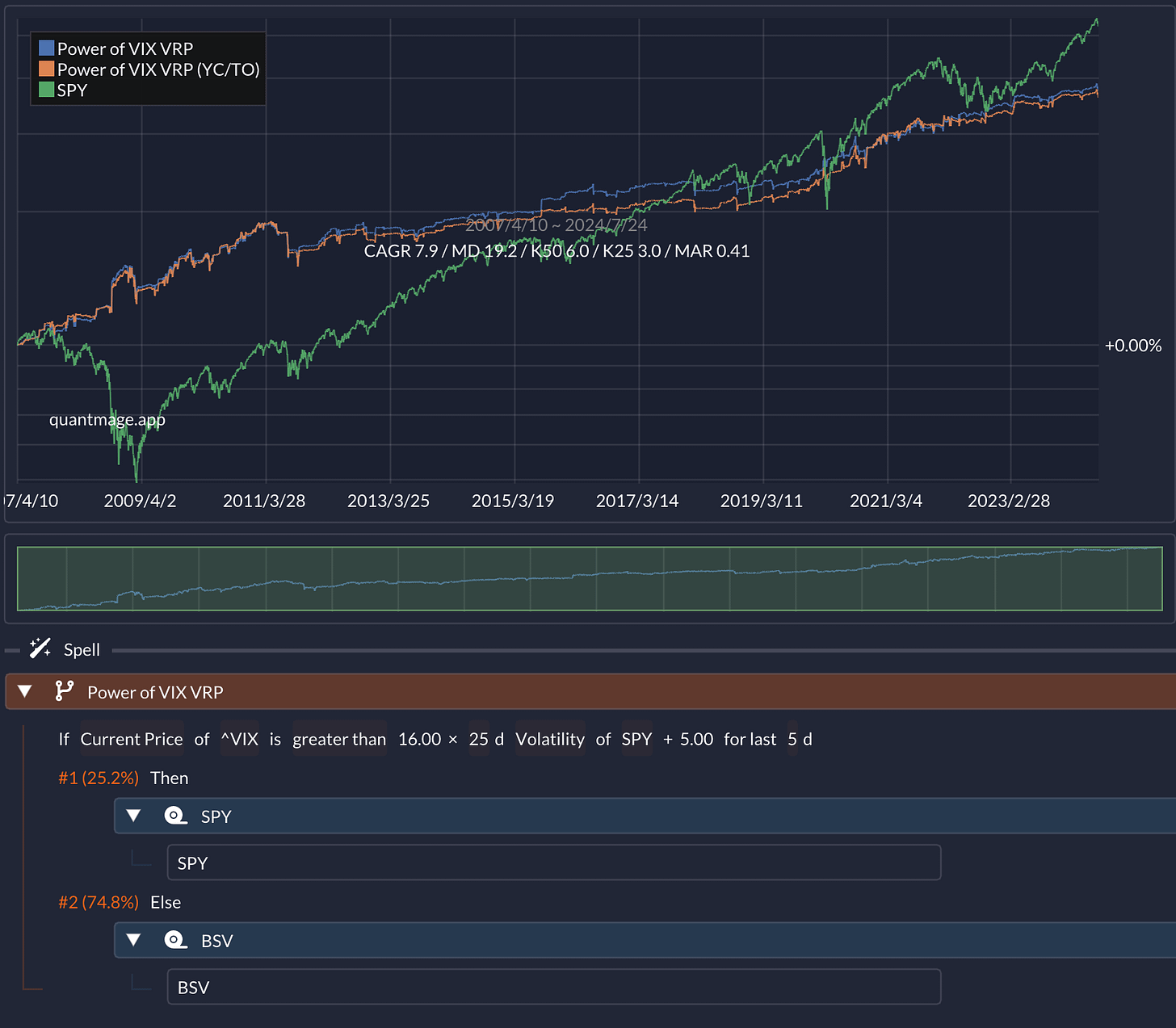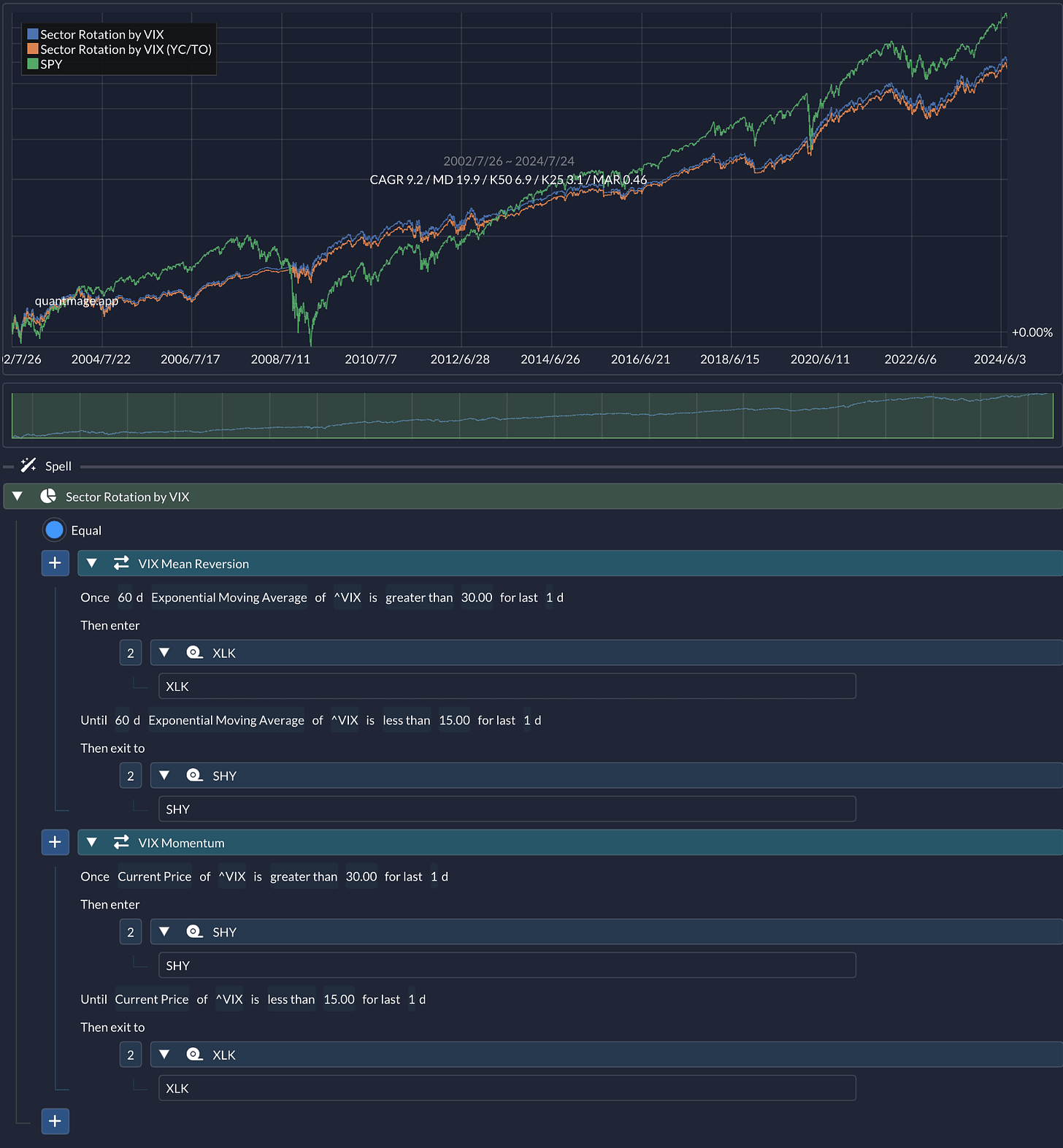The last few days have been tough on my portfolio. Today especially. Instead of obsessively checking my portfolio value and second-guessing my strategies, I decided to research some strategy ideas and share them with you. So here it goes. I’ve been looking into the idea of using VIX as a canary again since my last attempt didn’t quite pan out. Here are some interesting and promising approaches I’ve come across.
📣 Remember, this content is purely informational. It’s not investment advice or a recommendation to buy or sell any stocks. Always do your own research and consider talking to a financial professional before making any investment moves.
Existing Literature
Before diving into a subject, it’s always a good idea to check existing literature. I found two resources quite insightful: a blog post and a paper. To be honest, I couldn’t replicate most of the alphas mentioned in them. However, here are a few cases that produced decent historical performances.
Contango
Contango is when the futures price of a commodity is higher than its expected spot price at the end of the contract. This indicates that buyers expect the price of the commodity to increase over time and is considered bullish. The opposite is called backwardation. This strategy uses VIX in contango, compared to VIX3M, as a risk-on signal. While VIX measures implied volatility of S&P500 options with 30 days to expiration, VIX3M measures implied volatility of S&P500 options with 93 days (3 months) to expiration.
It shows a decent risk-adjusted return over a 16-year period, tactfully navigating around the Global Financial Crisis and COVID drawdowns. However, there is a hint of data mining, given the oddly specific weight value of 0.95 used.
Volatility Risk Premium
Volatility Risk Premium compares implied volatility to recent realized volatility, attempting to quantify how much “extra” premium S&P500 option sellers are charging investors for portfolio protection. Think of it as an insurance premium. This strategy uses 25-day historical volatility as the realized volatility and a positive VRP (> 5, to be precise) as a risk-on signal. The 16x is for annualizing it; you need to multiply the standard deviation of daily returns by the square root of 252 to annualize it.
Again, it shows a decent 17-year performance. The sensitivity to specific parameters like 25-day and 5.00 is still concerning.
Sector Rotation
This one is inspired by another paper, whose strategy positions into defensive sectors during periods of low volatility and into cyclical sectors during periods of high volatility. It relies on the mean reverting characteristic of VIX. This strategy combines mean reversion over a relatively longer term (defined by its 60-day exponential moving average) with momentum over a short term (defined by the current VIX level). In the bottom momentum block, it goes risk-off when VIX is high, which is opposite to the logic of the top mean reversion block.
By using XLK, a technology sector ETF, as the risk-on asset, it achieves a decent risk-adjusted return over a 22-year period.
Is VIX Broken?
Recently, people have started questioning the utility of VIX as the so-called “fear gauge” given its muted values over the last few years. They often blame the rising popularity of 0DTE options (zero-days-to-expiration options), which offer traders a more tactical approach for short-term strategies and exploded in popularity during the Coronavirus pandemic. However, there is an article expressing that VIX is still working as expected and another arguing that dampened volatility is more likely due to the surge in issuance of yield-enhancing structured products, not from 0DTE.
Regardless of whether VIX is broken by 0DTE or not, it’s interesting to look into strategies that utilize this new trend. Fortunately, there is VIX1D, a recently introduced 1-day VIX, which measures implied volatility for the current trading day. Here are two strategies that take advantage of it.
VIX1D Trend
This strategy checks VIX1D’s trend by comparing its exponential moving average to its simple moving average. It goes risk-on when it’s trending down.
It shows promising performance, but take it with a grain of salt given the very short backtesting history of just two years!
VIX1D Volatility
This strategy checks the 5-day volatility of VIX1D (yes, volatility of volatility) and goes risk-on when it’s low enough.
Not a bad performance, but the same caveat applies here.
Takeaway
What do you think? Any more ideas you’d like to try with VIX? Do you see the potential of VIX as a canary signal, or do you think the evidence isn’t strong enough? It might be that VIX isn’t really a leading indicator, and instead, using SPY to time VIX makes more sense, as argued in this aptly titled paper.
Let me know your thoughts and let’s keep the conversation going! 💬👇










Thx for the insights and ideas and sharing. Eager to play with ^VIX1D. I will attach some reliable* longer backtest circuit breakers as insurance due to the short history....
Oh, unrelated question: is there any place to view/access users public spells? (Access to a database is one of the few areas QM might be trailing other platforms...)